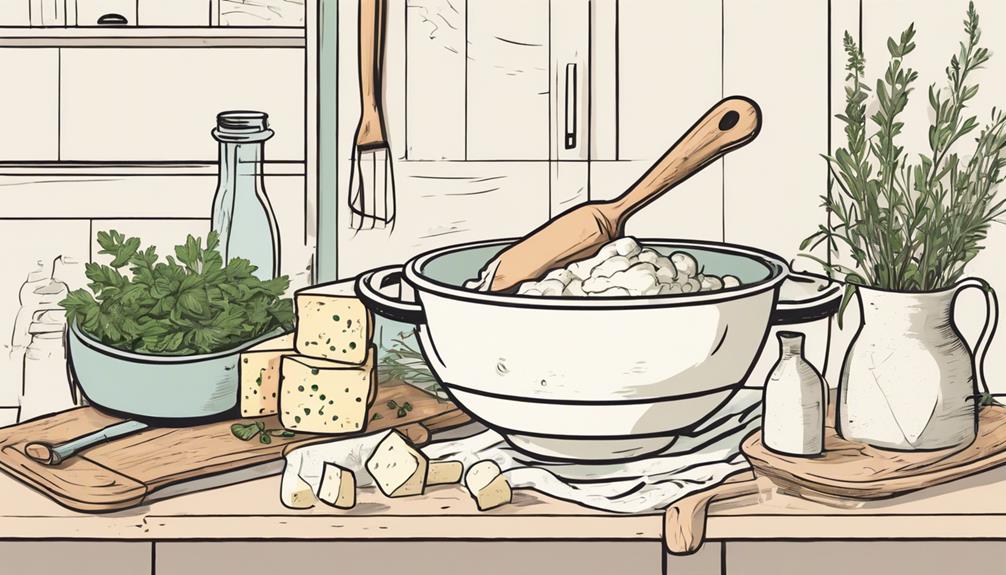See All: Cheese Making
Watch How To Do This Here…
YES! You can make cheese at home. Take our FREE 4-Part video training series to simplify cheesemaking for everyone. No waste. No overwhelm. No missing steps. You can make delicious, healthy cheese, even if you only have access to grocery store milk and regular kitchen equipment…
Click Here To Watch Step By Step Now
“Hey there. I recently started making cheese at home, and I’ve been having some trouble with my curds matting together. I’ve followed the basic instructions, but maybe I’m missing something? I’m getting to the pressing stage and the curds just clump up. Any tips or techniques would be really helpful. Thanks for any advice you can offer!” Thanks, Charlotte, Melbourne, Australia.
How Do You Prevent Curds From Matting Together?
Hey Charlotte! So glad you reached out for help. Let’s chat about how you can keep those pesky curds from matting. When curds mat together, it can mess with the texture and quality of your cheese. But don’t worry, there are several steps you can take to prevent this from happening, and most are pretty straightforward.
Why Matting Happens
Understanding why curds mat is the first step in preventing it. Curds mat when they expel too much moisture too quickly, causing them to stick together. This often happens because of:
- High Temperature: Exceeding the optimal temperature during the cheesemaking process can cause rapid whey expulsion.
- Over-stirring: Agitating the curds too much can cause them to break down, creating excess moisture that makes them clump together.
- Incorrect Cutting: Cutting the curds too large or too small can disrupt the proper whey drainage.
Optimal Curds Cutting Size and Techniques
Cutting the curds to the right size is crucial. Too large, and they hold too much moisture; too small, and they become too dry and easily clump together. Aim for uniformity:
- Cutting Tool: Use a long knife or curd cutter to ensure even, straight cuts. Smaller curds usually mean better moisture control.
- Size: Typically, for hard cheeses, aim for 1 cm cubes. For softer cheeses, slightly larger can be better.
Ensure even cutting by making horizontal and vertical cuts throughout the curd mass. This allows whey to drain uniformly.
Stirring Properly
Stirring helps to separate curds and promote whey drainage, but it’s important to do it just right.
- Gentle Motion: Use slow and gentle movements to avoid breaking the curds down too much.
- Frequency: Frequent but gentle stirring helps keep whey draining and prevents curds from settling and matting.
For example, in the early stages after cutting, aim to stir every 5 minutes gently. As curds firm up, you can reduce the frequency.
Temperature Control
Temperature plays a big role. Keeping it consistent is key.
- Heating: When heating the curds, increase the temperature gradually, typically no more than 1°C per minute.
- Goal Temperature: The target temperature varies with cheese type, but often it’s around 30-32°C for most cheeses.
Slow and steady helps ensure even whey expulsion and prevents curds from losing too much moisture too quickly.
Time & Patience
Cheesemaking isn’t a rush job, and curd matting often results from hurrying through the process.
- Rest Periods: Allow curds to rest after cutting and stirring. This period helps whey drainage stabilize.
- Handling: Handle curds delicately during draining and transferring to molds.
For example, letting curds sit undisturbed under the whey for about 5-10 minutes can help them expel whey at a manageable rate.
Using Salt and Other Additives
Salt can be your friend here. It helps to draw out moisture from the curds in a controlled manner.
- Brining: For cheeses that use brining, follow recommended times strictly.
- Dry Salting: Evenly distribute the salt to ensure consistent moisture removal.
Avoid over-salting, as it can make the cheese too dry, but under-salting will leave too much moisture in the curds, leading to matting.
Curd Washing
Washing curds with warm water can be an effective way to manage moisture.
- Temperature: Use water that’s close to the whey temperature to prevent shocking the curds.
- Washing Process: Stir gently to ensure all curds are equally exposed.
For example, curd washing is often used in Gouda making. It helps to remove some of the lactose and reduce acidity, which in turn can prevent curd matting.
Pressing with Care
When you get to the pressing stage, how you handle it can influence curd matting.
- Gradual Pressure: Apply pressure gradually to allow whey to expel slowly and evenly.
- Even Distribution: Ensure curds are evenly spread in the mold to avoid uneven pressure points.
For example, cheese molds with many small holes allow for even whey drainage, which can help keep curds from matting.
Practical Example
Take a moment to think about Cheddar cheese, Charlotte. During its making, after cutting the curd, it’s allowed to set and then stirred gently while heating. The curds shrivel slowly and evenly lose whey. Stirring keeps them from matting, and pressing in stages ensures a consistent texture.
Equipment Tips
Lastly, the right tools can make a world of difference.
- Curd Cutters: These come in various designs for different cheese types and help achieve uniform curd sizes.
- Cheese Molds: Ensure they have adequate drainage holes to facilitate even whey expulsion.
Investing in high-quality tools can remove much of the guesswork and result in better cheese consistency.
Final Thoughts…
Charlotte, thanks again for reaching out with your question. Remember, preventing curd matting is all about balance. Monitor your temperature, handle the curds with care, and give them the right conditions to expel whey slowly and evenly. Happy cheesemaking!
Return To: Cheese Making
Free Step By Step Cheese Making Videos…
YES! You can make cheese at home. Take our FREE 4-Part video training series to simplify cheesemaking for everyone. No waste. No overwhelm. No missing steps. You can make delicious, healthy cheese, even if you only have access to grocery store milk and regular kitchen equipment…

